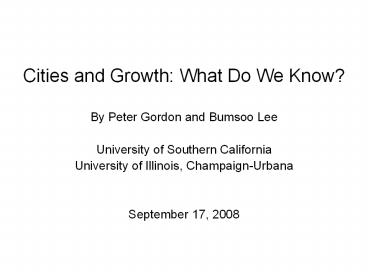Cities and Growth: What Do We Know? - PowerPoint PPT Presentation
1 / 20
Title:
Cities and Growth: What Do We Know?
Description:
... themselves so that agglomeration benefits dominate associated ... a recent NBER symposium on agglomeration economies, (http://www.nber.org/books/glae08-1 ... – PowerPoint PPT presentation
Number of Views:24
Avg rating:3.0/5.0
Title: Cities and Growth: What Do We Know?
1
- Cities and Growth What Do We Know?
- By Peter Gordon and Bumsoo Lee
- University of Southern California
- University of Illinois, Champaign-Urbana
- September 17, 2008
2
What Do We Know?
- Why are there cities?
- People have found ways to organize themselves so
that agglomeration benefits dominate associated
congestion costs. - Cities are the engines of growth.
- Economic growth springs from entrepreneurial
activity (e.g., discovery, J. Schumpeter). - Optimal urban scale discussions are not
helpful they suggest a static analysis.
3
- 5. Prefacing a recent NBER symposium on
agglomeration economies, (http//www.nber.org/book
s/glae08-1/), - Ed Glaser writes
- a central paradox of our time is that in
cities, industrial agglomerations remain
remarkably vital despite ever easier movement of
goods and knowledge across space.
4
Questions
- How can cities be congenial hosts to
entrepreneurship and discovery? - Can we understand the role of urban structure?
- Which spatial arrangements internalize positive
externalities while avoiding negative ones, in
light of all other trade-offs? - Gordon and Moore (E and P(A), 1989) discussed
land use optimizations that suggest an answer.
Are there plausible tests?
5
Traffic and Transportation
- Modern lifestyles generate massive volumes of
non-work travel during peak and off-peak hours. - Combining this with the absence of pricing, the
continued growth of cities (metro areas) is
remarkable. - Impending traffic doomsday is forever
impending.
6
Distribution of daily person-trips by trip
purpose and period of the week, 2001
In billions
7
Distribution of daily person-trips by trip
purpose and period of the week, 2001
In percent
8
Growth of average daily person-trips per person
by trip purpose and period of the week, 1990 to
2001
Work Non-Work
All
Family / School / Social /
Personal Church
Recreation
9
Industry Churning and Growth
- Cities succeed and maintain their status in the
urban ranking by churning industries (Duranton,
2006) as circumstances change. - Spatial form must change to make all of this
possible. Test more than metro-area average
densities. - Y year
- Zsector
- eemployment
- cMSA
10
Employment shares by location type
Results from GWR procedure.
11
Mean commute time by workplace location type vs.
metro population size (drive alone mode)
12
Urban Spatial Structure and Metro Growth
Empirical Model 1
- Glaesers (2003) supply-side urban growth model
- where Nt and Nt-1 denote population (employment)
size in 2000 and 1990, respectively - X is a vector of metropolitan attributes
- F is vector of spatial structure variables
dispersion and polycentricity
13
Estimation Results
14
Growth effects of spatial structure at different
metro sizes
6.05
15
Urban Structure and GrowthModel 2 Specification
- Locally Weighted Regression (LOESS)
- Allows the coefficients of spatial structure
variables to vary without restrictions - At each data point, a supply-side economic growth
model is fit to a subsample of observations that
are similar in Pop/Emp size (window size 41
obs.) - Similar size observations get more weight
16
LOESS Results
- LOESS results corroborate interaction term
significance of OLS results. - Estimate of coefficient for dispersion is about
zero near sample mean size pop (log pop 14, 1.25
million), positive for larger metros, negative
for smaller metros. - Estimate of coefficient for polycentricity always
near zero.
17
Model 2 Population Growth Model, Varying
Coefficients of Spatial Structure
18
Model 2 Employment Growth Model, Varying
Coefficients of Spatial Structure
19
Summary of Results
- The growth effects of spatial structure
(dispersion) were found to be contingent on
metropolitan size. - When small, a metropolitan area with more
clustered spatial form grows faster, realizing
agglomeration economies in this way. But as a
metro area becomes larger, more dispersion
accommodates greater growth. - Just as a metro takes on higher-order economic
functions to move up within an hierarchical urban
system, it also (concurrently) restructures its
spatial form in ways to mitigate congestion or
other diseconomies of size for continued growth
to be possible.
20
Conclusions
- Growth can be accommodated.
- 2. Continued productivity, growth and prosperity
require adaptable (open-ended) urban forms.
Suggests importance of flexible land, labor and
capital markets. Openness to spontaneous forms,
learning feedback and endogenous clustering (J.
Jacobs) -- rather than approaches like
pro-cluster policies. - 3. None of the involved markets are (or can be)
completely free or unhampered, but evidence of
performance and spatial change is impressive.































